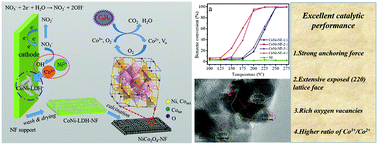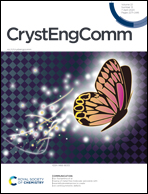In situ anchored NiCo2O4 on a nickel foam as a monolithic catalyst by electro-deposition for improved benzene combustion performance
Abstract
In situ designed monolithic catalysts possess a bright prospect in practical industrial catalytic applications owing to their strong anchoring force and lower pressure drop. In this study, a series of NiCo2O4 nickel foam-based monolithic catalysts were successfully prepared via an in situ electro-deposition strategy. The active phase was strongly and vertically anchored on a nickel foam, leading to a catalyst with a stable structure, abundant surface areas and an excellent electronic transmission capacity. Moreover, the as-prepared catalysts exhibited abundant structural defects, which can be attributed to the violent reaction rate. All the samples assuredly possessed excellent benzene oxidation performance, and the CoNi-NF-2 : 1 sample exhibited a superior activity, oxidizing about 90% of benzene (T90) at 198 °C under a gaseous hourly space velocity (GHSV) of 6000 h−1. A conclusion can be rationally drawn that the superior catalytic performance and the stability of the catalysts are primarily attributable to the strong anchoring force, rich oxygen vacancies, and the higher Co3+/Co2+ ratio according to the relevant characterizations. Furthermore, the benzene combustion mechanism was summarized by adequately studying the above conclusions and previous studies. This work indicates a promising strategy to design highly active monolithic catalysts with abundant defects, which potentially pave the way for the thorough removal of industrial benzene.



 Please wait while we load your content...
Please wait while we load your content...